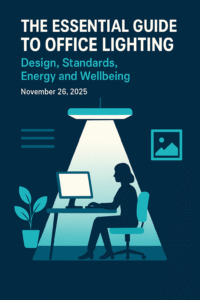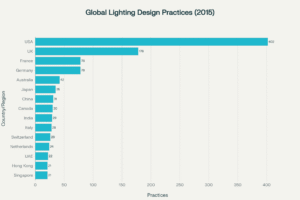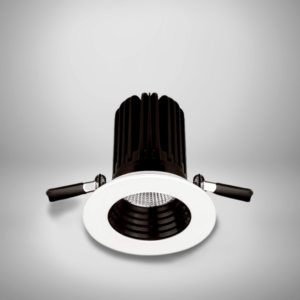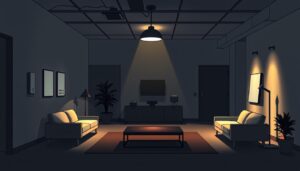Did you know that a meticulously crafted lighting scheme can metamorphose even the most unassuming space into a veritable architectural marvel? Globally, architects and designers are leveraging the potency of light to sculpt the atmosphere, underscore architectural elements, and orchestrate dramatic effects that magnify the built environment’s stature. The interplay between natural and artificial illumination, coupled with the strategic manipulation of shadows, constitutes a captivating and continually evolving art form known as light to enhance architectural features.
In this exhaustive examination, we will explore the transformative impact of architectural lighting, revealing methodologies that can metamorphose a space from the ordinary to the extraordinary. Whether you are a design professional or a fervent enthusiast, you will uncover the secrets behind how accent lighting and deliberate shadow manipulation can accentuate architectural nuances, engender depth, and cultivate an atmosphere that elevates the built environment.
Introduction to Architectural Lighting
Light is fundamental in architecture, shaping how spaces are perceived and experienced. Proper lighting design enhances both the aesthetic and practical aspects of a space, illuminating architectural elements and dramatizing architecture through carefully considered feature lighting. This section will explore the significance of natural and artificial lighting in highlighting textures, creating depth, and emphasising design elements.
The Importance of Light in Architecture
Architectural lighting plays a critical role in shaping the overall ambiance and functionality of a building. Richard Kelly, a prominent figure in the field, observed that there are three elemental kinds of light: focal glow (task lighting), ambient luminescence (ambient lighting), and play of brilliants (accent lighting). These distinct types of light work together to enhance the experience of a space, catering to both practical and emotional needs.
Overview of Light Types
- Task Lighting – Provides focused illumination for specific activities, such as reading or workspace lighting.
- Ambient Lighting – Creates a general, uniform level of illumination throughout a space, ensuring safe movement and a comfortable atmosphere.
- Accent Lighting – Highlights architectural features, artwork, or other design elements, adding visual interest and drama.
The strategic use of these light types, along with considerations of intensity, brightness, diffusion, and direction, can dramatically enhance the perception and experience of a built environment. By integrating natural and artificial lighting, architects and designers can create spaces that are both functional and aesthetically captivating.
Understanding Natural Light
In the domain of architectural illumination, natural light’s role is indispensable, moulding and enriching the environments we occupy. By astutely employing sunlight, designers can orchestrate mesmerising visual spectacles, highlighting a structure’s architectural nuances and instilling a sense of expansiveness and serenity.
How Natural Light Shapes Spaces
The judicious positioning of windows, skylights, and other apertures enables sunlight to permeate interior realms, generating light and shadow patterns that imbue spaces with depth, drama, and visual allure. A report by the Environmental Protection Agency reveals that individuals spend approximately 90% of their lives indoors, underscoring the significance of integrating natural illumination within building interiors. Skylights, in particular, can serve as a striking focal point or provide gentle, filtered illumination in expansive areas that conventional windows cannot adequately illuminate.
The alignment of these natural light sources is equally significant. For example, west-facing skylights receive robust afternoon sunlight, whereas east-facing ones absorb more morning light, presenting diverse lighting scenarios. Designers can further enhance aesthetic value by experimenting with creative skylight geometries, such as circular, square, or organic forms.
Enhancing Views with Natural Light
Filtered sunlight through perforated walls, lattices, or ceiling openings can provide thermal comfort and natural ventilation, while materials like milky glass panels and various fabrics can transform direct sunlight into visually captivating diffused glimmers. Combining textured glass channels with transparent ones can achieve varying privacy levels while modulating light intensities, fostering a balanced interplay between indoor and outdoor environments.
Natural lighting can imbue a space with a sense of vastness, as affirmed by leading designers and architects. Integrating natural light into building design not only elevates a space’s visual appeal but also fosters sustainability, comfort, and overall well-being. By grasping the subtleties of how natural light moulds and accentuates architectural elements, designers can craft captivating and practical spaces that harmoniously merge the indoor and outdoor spheres.
The right balance of natural light in architectural design transcends mere aesthetic enhancement, embracing sustainability, comfort, and overall well-being. By comprehending the intricacies of how natural light influences and highlights architectural features, designers can forge spaces that are both visually stunning and functionally adept, seamlessly integrating the indoor and outdoor realms.
Artificial Lighting Techniques
The strategic deployment of artificial lighting is imperative for the enhancement of architectural features and the creation of captivating indoor environments. Artificial lighting techniques encompass a diverse range of approaches, each with its own unique purpose and effect. From direct lighting to diffused and accent lighting, the selective application of these methods can significantly impact the overall ambiance and functionality of a space.
Types of Artificial Lighting
- Direct Lighting is typically employed in work or task areas like kitchen worktops, offices, and workspaces, providing focused illumination for specific tasks.
- Indirect Lighting, a system that produces soft light by directing the light source to another surface, is commonly used in relaxation spaces such as living rooms, dormitories, hospitals, and spas.
- Diffused Lighting, where light passes through a diffuser element and is directed in all directions without creating light beams, results in a quite homogeneous ambient lighting, often found in bedrooms and relaxation areas.
- Effect Lighting, which creates a dramatic effect by embedding the light source in the ceiling or architectural elements, is often used in landscaping, façades, and crown molding to highlight specific features.
- Accent Lighting, used to illuminate points of interest like paintings or sculptures, is commonly found in residential and commercial spaces as well as museums.
- Wall Washing involves creating scenic lighting effects by using a series of light points or LED strips to highlight facades or architectural features.
Choosing the Right Fixtures
The strategic selection of luminaires is critical for achieving the desired effect. Direct lighting can be effective for illuminating work areas like office desks and kitchen worktops, but the glare can be irritating to users, necessitating careful positioning to avoid deep shadows.
Indirect lighting, which does not illuminate surfaces directly but creates a soft glow, is suitable for relaxation spaces like hospital rooms, restaurants, living rooms, and bedrooms.
Diffused lighting, achieved through a diffusing element like coloured acrylic plates, distributes light homogeneously across surfaces, creating a tranquil effect ideal for bedrooms and relaxation spaces. Effect lighting, embedded in ceilings or walls, highlights the illumination source, while wall-washing and light grazing techniques can be used to bring out the unique texture and depth of architectural features.
| Lighting Technique | Typical Application | Key Characteristics |
|---|---|---|
| Direct Lighting | Work areas, task-oriented spaces | Focused illumination, potentially irritating glare |
| Indirect Lighting | Relaxation spaces, hospitals, restaurants | Soft, diffused glow, calming ambience |
| Diffused Lighting | Bedrooms, relaxation areas | Homogeneous distribution, tranquil effect |
| Effect Lighting | Landscaping, façades, architectural features | Highlights the light source, dramatic effects |
| Accent Lighting | Residential, commercial, and museum spaces | Illuminates specific points of interest |
| Wall Washing | Façades, architectural features | Scenic lighting effects, highlights textures and depth |
By thoughtfully integrating various lighting techniques, designers can create captivating spaces that not only meet functional requirements but also enhance the architectural features and user experience within a built environment.
The Role of Colour in Lighting
Colour’s influence on the perception of light and shadow within architectural spaces is profound. Architects and designers, through the strategic use of coloured lighting, can craft captivating atmospheres. These atmospheres significantly enhance the overall experience of a built environment.
Colour Temperature and Mood
The colour temperature of light, quantified in Kelvins, profoundly impacts emotional responses. Warm colour temperatures, akin to those from incandescent bulbs, elicit feelings of coziness and comfort. In contrast, cool colour temperatures, characteristic of LED sources, induce alertness and sophistication. By judiciously incorporating these colour temperatures, architects can dramatize architecture and highlight architectural details, effectively manipulating the mood and perception of a space.
Using Coloured Lighting Strategically
- Warm, yellowish tones are ideal for creating a welcoming, friendly atmosphere, as seen in restaurants and hospitality venues.
- Cool, bluish hues can evoke a sense of tranquility and relaxation, making them suitable for spas and healthcare facilities.
- Vibrant, saturated colours can illuminate architectural elements and add visual interest, often used in commercial and retail spaces.
Through the thoughtful highlighting of architectural details with coloured lighting, architects and designers can transform perceived spatial qualities. This transformation dramatizes architecture and creates unique, memorable experiences for occupants.
The adaptability of modern lighting technologies, such as LED systems, enables dynamic colour changes and customisation. This adaptability significantly expands the possibilities for illuminating architectural elements and highlighting architectural details in innovative ways.
Shadow and Contrast in Design
The interplay of light and shadow is a fundamental aspect of architectural design, imbuing built environments with depth, dimension, and visual allure. Shadows delineate the form and structure of architectural elements, imbuing spaces with a sense of depth and complexity. Architects and designers employ shadows to accentuate specific features, directing the viewer’s gaze and eliciting emotional responses.
Creating Depth with Shadows
The sun’s movement throughout the day casts shadows that profoundly alter the experience of a space. Elements such as pergolas, sheds, and mashrabiya in the Oaxaca’s Historical Archive Building create luminous textures by filtering natural light. The Gardeners’ Pavilion at Club Hípico de Santiago transforms a simple shelter into an ethereal drawing through the play of light and shadows cast by perforated bricks.
Movable furniture, exemplified in the ARC’TERYX Store by STILL YOUNG, enables the creation of dynamic light and shadow designs that evolve with the solar movement. By manipulating the interplay of light and darkness, architects sculpt the environment, evoking a spectrum of sensations and guiding the user’s experience.
Highlighting Architectural Features
Shadows can be strategically employed to draw attention to specific architectural features, creating visual emphasis and drama. The MNMA studio’s renovation of the Selo Store juxtaposes an austere construction with metropolitan surroundings, utilising punctual yet subtle and diffuse feature lighting to craft a geometric atmosphere.
In the Rombo IV residence by Miguel Angel Aragonés, facade lighting is complemented by natural lighting to evoke diverse atmospheres, transitioning from calm and serene to energetic and ethereal. The interplay of architectural illumination and shadows accentuates the building’s form and elements, creating a dynamic and engaging visual experience.
Attaining the right equilibrium between light and darkness is critical in architectural design. By meticulously managing the contrast between illumination and shadow, designers can elevate the overall aesthetic and emotional impact of a space, guiding the viewer’s attention and evoking a profound sense of place.

Lighting for Different Architectural Styles
The interplay of light and shadow is fundamental in accentuating architectural design. Various architectural styles, ranging from modern minimalism to historic grandeur, necessitate bespoke lighting solutions. These must complement their distinct characteristics. We will examine how lighting can augment the aesthetics of diverse architectural aesthetics.
Modern Architecture
In modern, minimalist interiors, the judicious application of light and shadow can amplify the sense of simplicity and elegance. Luminaires , which are generally at least 45% more energy-efficient than fluorescent bulbs, are often the preferred choice for modern architectural lighting. The clean lines and geometric forms inherent in modern design are optimally suited for the strategic placement of task lighting, accent lighting, and ambient illumination. This creates a harmonious, streamlined ambience.
Historical Buildings
Lighting historical buildings demands a nuanced approach, aiming to highlight the craftsmanship and depth of these spaces without compromising their architectural integrity. Lighting design at a former steel plant in Pennsylvania showcased a storytelling element where lights transitioned in shades, reflecting the historical significance of the space. Techniques such as wall washers, backlighting, and subtle accent lighting can accentuate the intricacies and ornate features that define historic structures.
The ultimate objective of accentuating architectural design with light is to craft an immersive, visually captivating environment. This environment should enhance the user’s experience and appreciation of the space. By integrating light to enhance architectural features thoughtfully, designers can elevate architectural lighting to unprecedented heights. This showcases the beauty and unique qualities of each building.
The Influence of Technology on Lighting
The transformation of lighting technology has significantly altered the design and experience of architectural spaces. The advent of LED lighting has revolutionised architectural illumination, introducing enhanced energy efficiency, versatility, and creative scope.
Smart Lighting Solutions
Architects and designers increasingly favour LED lighting for its capacity to deliver a broad spectrum of accent lighting, highlighting architectural details, and illuminating architectural elements. LEDs surpass traditional light sources by enabling programmable adjustments in brightness, colour, and timing. This adaptability is further amplified by smart lighting systems, which offer precise control over these variables. Such systems empower users to craft bespoke lighting schemes, elevating both the functionality and aesthetic value of a structure.
Adaptive Lighting Systems
Adaptive lighting systems extend the versatility of LED technology by automatically modulating lighting conditions in response to environmental stimuli. These systems employ sensors to monitor ambient light, occupancy, and weather, dynamically adjusting artificial illumination to ensure optimal levels. This not only optimises energy consumption but also enriches the user experience through the creation of a responsive and adaptive lighting environment.
The incorporation of technology into architectural lighting has unveiled a plethora of opportunities for designers and property owners. By leveraging smart and adaptive lighting solutions, they can forge spaces that are visually captivating, highly functional, and energy-efficient.
Incorporating Outdoor Lighting
In the realm of architectural design, the strategic use of outdoor lighting can dramatically enhance the aesthetic appeal and functionality of a space. From dramatising architecture to creating inviting outdoor areas, the integration of well-planned lighting schemes plays a critical role in elevating the overall experience.
Landscape Lighting Ideas
One of the key trends in outdoor lighting is the use of feature lighting to highlight architectural details and landscape elements. Uplighting, for instance, can accentuate the texture of various features, such as façades, columns, trees, and even sculptures. Strategically placed outdoor lights can also illuminate colourful blooms and create a serene atmosphere in a landscape, encouraging more outdoor usage and connection with nature.
Another emerging trend is the use of smart lighting solutions, which offer advanced control and flexibility. These systems often include features like motion sensors, automatic timers, and voice control through smart home assistants or smartphone apps, allowing for efficient and customised outdoor lighting management.
Safety and Aesthetic Considerations
When it comes to outdoor lighting, it is essential to strike a balance between functionality and visual appeal. Facade lighting, for example, can dramatically dramatise the architecture, while also ensuring the safety of pathways and entryways. The use of eco-friendly materials, such as wood, stone, and copper, in outdoor lighting fixtures can blend seamlessly with the natural environment, creating a harmonious and sustainable aesthetic.
Another trend worth considering is the concept of “Dark Sky Lighting,” which aims to reduce light pollution by directing light downward and minimising glare and light spill. This approach helps maintain the natural night environment and prevent artificial light from obscuring views of the stars, contributing to a more sustainable and environmentally-conscious outdoor lighting design.
| Lighting Trend | Description | Benefits |
|---|---|---|
| Smart Lighting | Advanced control and flexibility with features like motion sensors, automatic timers, and voice control | Efficient and customised outdoor lighting management |
| Dark Sky Lighting | Directing light downward to reduce light pollution and maintain the natural night environment | Preserves views of stars and promotes environmental sustainability |
| Natural Materials | Using fixtures made from wood, stone, and copper that blend seamlessly with outdoor environments | Eco-friendly design with a harmonious aesthetic |
Maintenance and Sustainability in Lighting
The longevity and sustainability of lighting installations are imperative in any project. The recent proliferation of LED lighting has transformed the sector, introducing energy-efficient and low-maintenance alternatives. For instance, the Grey Lynn apartment renovation employed recessed task lighting and Carrara marble to achieve a spotlighting effect. This approach leveraged the versatility and energy-saving attributes of LED technology.
Energy Efficiency Solutions
Advances in lighting technology have enabled the attainment of energy efficiency without sacrificing the quality of architectural illumination. In the Canterbury home renovation, LED tracks were embedded within shelving, delivering sparse yet effective illumination. The Dune House exemplified the integration of transparent blown glass pendants as designer lighting. The Closeburn Lodge project, on the other hand, utilised the striking Light Ring Horizontal designer pendants by Massimo Castagna to foster an indoor-outdoor connection.
Long-Term Maintenance Tips
- Employ multi-level switching to tailor lighting for specific tasks, reducing energy consumption and maintenance needs.
- Adopt the versatility of LED recessed lighting, which offers a spectrum of tones and power outputs to cater to various requirements.
- Invest in superior fixtures and components to guarantee the longevity of your lighting system, reducing the necessity for frequent replacements.
- Regularly maintain and clean lighting fixtures to enhance their performance and prevent premature degradation.
By integrating these strategies, architects, lighting designers, and facility managers can craft architectural illumination that not only augments the aesthetic value of a structure but also champions sustainability and long-term maintenance. This approach leads to a more efficient and economically viable lighting solution.
Conclusion: The Future of Architectural Lighting
In our examination of architectural lighting, a trajectory of significant progress is evident. The convergence of smart technologies and eco-conscious lighting solutions heralds a new era for this evolving sector. These emerging trends promise to redefine the architectural lighting landscape, ushering in a future replete with innovation and sustainability.
Emerging Trends
The advent of LED technology has revolutionised the architectural lighting domain, introducing enhanced energy efficiency, longevity, and adaptability. Building on this foundation, the integration of intelligent lighting systems is anticipated. These systems will dynamically adjust illumination in response to occupancy and daylight availability. This development not only optimises energy usage but also crafts more personalised and responsive environments within structures.
The imperative for sustainability will continue to propel the industry forward, aligning with global efforts towards a more environmentally conscious future. Architectural lighting systems prioritising energy efficiency and incorporating renewable energy will gain prominence. Such systems will significantly contribute to the sustainability of contemporary architectural and construction practices.
Final Thoughts on Light and Architecture
Light serves as a transformative agent in the hands of architects and designers, fundamentally altering our perception and interaction with built environments. It plays a critical role in accentuating architectural features, establishing ambiance, and ensuring safety. As the architectural lighting market expands, we foresee the emergence of groundbreaking solutions. These innovations will redefine the symbiotic relationship between light and architecture, elevating the aesthetic and functional aspects of built spaces.
FAQ
What is the importance of light in architecture?
Light is a fundamental element in architecture, profoundly influencing how spaces are perceived and experienced. Optimal lighting design enhances both the aesthetic and practical aspects of a space. It highlights textures, creates depth, and accentuates design elements, significantly impacting the overall ambiance.
What are the different types of lighting used in architectural design?
Architectural lighting encompasses ambient, task, and accent lighting, each with a specific purpose in the design scheme. Designers must harmonise these lighting types to create a cohesive and functional lighting plan. This plan should enhance architectural features and support various activities within a space.
How can natural light be manipulated to improve architectural spaces?
Strategic placement of windows, skylights, and other openings allows sunlight penetration, creating patterns of light and shadow. This enhances interior drama and visual interest. Techniques such as using reflective surfaces and transparent materials can visually expand spaces, creating an impression of openness.
What role does colour play in architectural lighting design?
Colour significantly impacts how light and shadow are perceived. Coloured lighting can evoke different emotions and atmospheres. The colours of walls and furnishings influence the intensity and quality of shadows. Understanding colour temperature and strategically using coloured lighting can enhance architectural features and create specific ambiances.
How can shadows be used to enhance architectural design?
Shadows add dimension and contrast, making spaces feel dynamic and alive. They help define the form and structure of architectural elements, adding depth and complexity. Designers can use shadows strategically to create visual interest and highlight specific architectural features, while maintaining the balance between light and shadow.
How can lighting be adapted to different architectural styles?
Lighting approaches should complement the unique characteristics of various architectural styles. For modern minimalist interiors, the subtle interplay of light and shadow can enhance simplicity and elegance. In historic and traditional spaces, lighting can accentuate craftsmanship and depth. Choosing the right lighting solutions is critical to enhance the architectural style.
How is technology influencing architectural lighting design?
Advancements in technology, such as LED lighting and smart lighting systems, are transforming architectural lighting design. LED lighting’s energy efficiency and versatility, along with its ability to produce a wide range of colours and intensities, allow for precise control over lighting conditions. This enhances flexibility and functionality in architectural interiors.
What are the key considerations for outdoor lighting in architectural design?
Outdoor lighting for architecture must balance functionality and visual appeal. Landscape lighting ideas can dramatise architecture and create stunning nighttime scenes, while also addressing safety considerations. Designers must carefully consider the balance between highlighting facade details and creating inviting outdoor spaces.
How can lighting design be made more sustainable and energy-efficient?
Sustainable lighting solutions, such as LED technology, and smart lighting systems that enable precise control over lighting conditions, are essential for reducing energy consumption. These approaches ensure the long-term maintenance and effectiveness of lighting installations. Incorporating these energy-efficient solutions is critical for creating sustainable and environmentally responsible architectural lighting designs.












